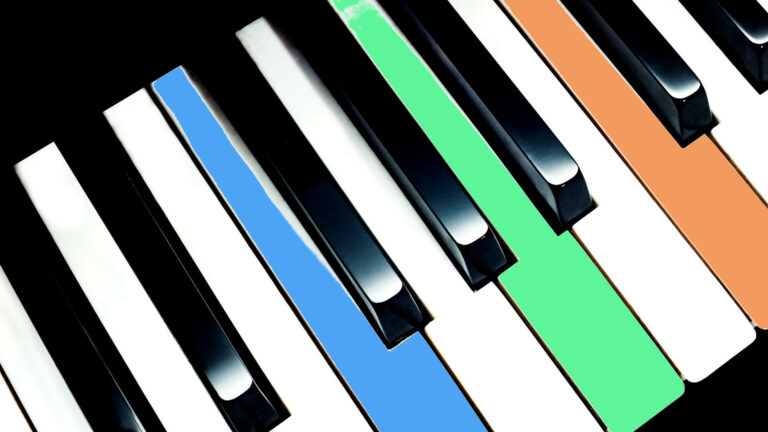In this article, I will show you how to use chord inversions to transition chords smoothly within the song you are playing. This is to make sure that your hands don’t need to travel all the way to another segment on your keyboard just to play the next chord in your progression.
We have all seen very advanced piano virtuosos play a very difficult and fast piece of music. Their hands flying all over the place in a flurry of motion. It is nice to watch and we dream of being able to do the same. But the truth of the matter is, that it takes a lot of practice to control that kind of motion with laser point accuracy.
Even if you do have that level of accuracy. Just because you can, doesn’t mean you should! Less is often more!
Using inversions as you will see will give your music character. It will allow you to play melodic chords and harmonies. You will tap into different voices and you will be able to change the ‘feel’ of your song.
Not to mention that playing the piano should also be able to give you peace. You should be able to relax. The less motion you use, the less strain you will cause to your body. And that is true even for those hard songs with lots of motion. A lot of time and effort is taken into limiting the amount of strain to your body while studying those pieces.
Looking for something more basic? Don’t have a clue about what chords are or how you build them?
Check out this post instead ► Basic Piano Chords – Theory – Diatonic Sequence
Oh and if you were looking for chord formulas instead; I have them right here for you.
► Chord Formulas
What Are Inversions?
So what are these inversions? I guess the simplest explanation would be that an inversion of a chord is when you place the notes of that chord in a different order. I guess it would be best explained by example.
Learn all about chords and inversions in a practical and interactive way.
Start your free trial here ► https://go.flowkey.com/pianowalk
Triad Inversions
Triad Root Position
The root position is the chord in its natural clustered form like for instance the triad of C major according to its formula: 1 – 3 – 5

Triad First Inversion
The first inversion of a triad is when the root note of the base cluster is played an octave higher. This turns the formula of our instance into: 3 – 5 – 1

Triad Second Inversion
The second inversion of a triad is when the root note and the third are both played an octave higher. This turns the formula of our instance into: 5 – 1 – 3




Just click the images ►
Triad Chord Progression Example
I – V – VI – IV progression
We can derive the chords for the I – V – VI – IV progression in the C major scale using this table
| C | D | E | F | G | A | B |
| I | II | III | IV | V | VI | VII |
| maj | min | min | maj | maj | min | min ♭5 |
I maj – V maj – VI min – IV maj ► C maj – G maj – A min – F maj
You can learn more about this from my blog post about Piano Scales: The Major Scale.
Played in Root Position
Here is what the progression in the C major scale sounds like when all the chords are played in root position.
It doesn’t sound bad, but it sounds very basic and the chords jump a lot.




Played with Inversions
Here is the same progression but using inversions to keep the chords from jumping around.
I am sure you will agree that it sounds a lot smoother than the previous example. And look at how little the chords need to jump.





Scale, chord, arpeggio and cadence studies in all major and minor keys presented in a convenient two-page format.
Tetrad Inversions
This is pretty much a repeat of what we did for the triads, but for completeness sake. (And because it is nice to hear the examples.)
Tetrad Root Position
The root position is the chord in its natural clustered form. For instance, the tetrad of C major 7, according to its formula: 1 – 3 – 5 – 7

Tetrad First Inversion
The first inversion of a tetrad is when the root note of the base cluster is played an octave higher. This turns the formula of our instance into: 3 – 5 – 7 – 1

Tetrad Second Inversion
The second inversion of a tetrad is when the root note and the third are both played an octave higher. This turns the formula of our instance into: 5 – 7 – 1 – 3

Tetrad Third Inversion
The third inversion of a tetrad is when the root note, the third and the fifth are all played an octave higher. This turns the formula of our instance into: 7 – 1 – 3 – 5



The Chord Wheel will help you find relations between chords and scales to help you improvise.
The Piano Chord Chart Poster is a great visual reminder of the most important chords in the most important scales.
Tetrad Chord Progression Example
I – V – VI – IV progression
We can derive the chords for the I – V – VI – IV progression in the C major scale using this table
| C | D | E | F | G | A | B |
| I | II | III | IV | V | VI | VII |
| maj 7 | min 7 | min 7 | maj 7 | dom 7 | min 7 | min 7 ♭5 |
I maj 7 – V 7 – VI min 7 – IV maj 7 ► C maj 7 – G 7 – A min 7 – F maj 7
You can learn more about this from my blog post about Piano Scales: The Major Scale.
Played in Root Position
Here is what the progression in the C major scale sounds like when all the chords are played in root position.
As with the triads, the tetrads don’t sound bad, but it also sounds very basic and the chords jump a lot.




Played with Inversions
Here is the same progression using tetrads but using inversions to keep the chords from jumping around.
With tetrads I find that the effect of inversion is much bigger than what you get from inverting triads. This is now starting to sound like some genuine smooth jazz.




Two Basic Rules
So there are two rules when it comes to grouping your notes and using inversions to keep your hand movement limited to a minimum.
When progressing from one chord to the next:
- See which notes are common in both chords and keep them in place
- If the chord is an adjacent letter in the alphabet use the same inversion and move it one note up or down depending if the chord is the next or the previous letter in the alphabet
Conclusion
That was again quite a bit of information to process… I hope everything was explained with adequate clarity. If anything needs more explaining, please do let me know in the comment section and I will update this post accordingly.
My number one recommendation to learn the piano in a fun and hassle-free manner is a program called Flowkey. Go try it out for free ► https://go.flowkey.com/pianowalk


7 Comments
This looks great. I have had some keyboard lessons. I shall have to visit on a regular basis. Keep up the good work.
Hello Adrian,
Thank you for the compliment!
Enjoy your day!
Tom
Wow! This is amazing. My sister has started to take an interest in the piano and after reading this I have already sent her the link to check it out.
There is so much information to take in and you are so organized with all the content that it really helps to maneuver around to where you want to be. I know very little about the piano but after reading this I feel as if I can actually have a conversation with my sister about it now! Thank you for taking the time to help others that have the same passion as you do!
Hey Emma,
Thanks for your compliments! I hope your sister will enjoy my content.
Have a wonderful day.
Tom
Great illustrations, thanks! It’s always good to refresh your memory on that.
Thank you for help us.
You are very welcome!